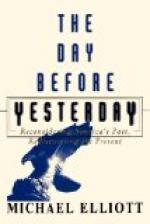My brother George was twice Secretary of State for India. The Queen was fond of suggesting amendments in the wording of dispatches relating to India, whilst not altering their sense. My brother tells me that the alterations suggested by the Queen were invariably in the direction of simplification. The Queen had a knack of stripping away unnecessary verbiage and reducing a sentence to its simplest form, in which its meaning was unmistakably clear.
All Queen Victoria’s tastes were simple. She liked simplicity in dress, in food, and in her surroundings. If I may say so without disrespect, I think that Queen Victoria’s great hold on her people came from the fact that, in spite of her high station, she had the ideals, the tastes, the likes and dislikes of the average clean-living, clean-minded wife of the average British professional man, together with the strict ideals as to the sanctity of the marriage-tie, the strong sense of duty, and the high moral standard such wives usually possess.
It is, of course, the easy fashion now to sneer at Victorian standards. To my mind they embody all that is clean and sound in the nation. It does not follow that because Victorians revelled in hideous wall-papers and loved ugly furniture, that therefore their points-of-view were mistaken ones. There are things more important than wall-papers. They certainly liked the obvious in painting, in music, and perhaps in literature, but it hardly seems to follow logically from that, that their conceptions of a man’s duty to his wife, family, and country were necessarily false ones. They were not afflicted with the perpetual modern restlessness, nor did they spend “their time in nothing else, but either to tell, or to hear some new thing”; still, all their ideas seem to me eminently sweet and wholesome.
In her old age my mother was the last person living who had seen George III. She remembered perfectly seeing the old King, in one of his rare lucid intervals, driving through London, when he was enthusiastically cheered.
She was also the last person alive who had been at Carlton House which was pulled down in 1826. My mother at the age of twelve danced as a solo “The Spanish Shawl dance” before George IV. at the Pavilion, Brighton. The King was so delighted with her dancing that he went up to her and said, “You are a very pretty little girl, and you dance charmingly. Now is there anything I can do for you?” The child answered, “Yes, there is. Your Majesty can bring me some ham sandwiches and a glass of port-wine negus, for I am very hungry,” and to do George IV. justice, he promptly brought them. My mother was painted by a French artist doing her “shawl dance,” and if it is a faithful likeness, she must have been an extraordinarily pretty child. On another occasion at a children’s party at Carlton House, my uncle, General Lord Alexander Russell, a very outspoken little boy, had been warned by his mother, the Duchess of Bedford, that though the King wore a palpable wig, he was to take no notice whatever of it. To my mother’s dismay, she heard her little brother go up to the King and say, “I know that your Majesty wears a wig, but I’ve been told not to say anything about it, so I promised not to tell any one.”




